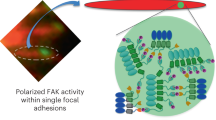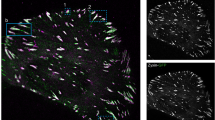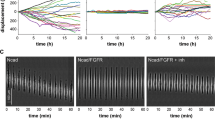Abstract
THE intracellular protein tyrosine kinase FAK (focal adhesion kinase) was originally identified by its high level of tyrosine phosphorylation in v-src-transformed cells1á¤-4. FAK is also highly phosphorylated during early development5,6. In cultured cells it is localized to focal adhesion contacts and becomes phosphorylated and activated in response to integrin-mediated binding of cells to the extracellular matrix, suggesting an important role in cell adhesion and/or migration. We have generated FAK-deficient mice by gene targeting to examine the role of FAK during development. Mutant embryos displayed a general defect of mesoderm development, and cells from these embryos had reduced mobilityin vitro. Surprisingly, the number of focal adhesions was increased in FAK-deficient cells, suggesting that FAK may be involved in the turnover of focal adhesion contacts during cell migration.
This is a preview of subscription content, access via your institution
Access options
Subscribe to this journal
Receive 51 print issues and online access
$199.00 per year
only $3.90 per issue
Buy this article
- Purchase on Springer Link
- Instant access to full article PDF
Prices may be subject to local taxes which are calculated during checkout
Similar content being viewed by others
References
Kanner, S. B., Reynolds, A. B., Vines, R. R. & Parsons, J. T. Proc. natn. Acad. Sci. U.S.A. 87, 3328–3332 (1990).
Schaller, M. D. et al. Proc. natn. Acad. Sci. U.S.A. 89, 5192–5196 (1992).
Hanks, S. K., Calalb, M. B., Harper, M. C. & Patel, S. K. Proc. natn. Acad. Sci. U.S.A. 89, 8487–8491 (1992).
Hanks, S. & Hunter, T. FASEB J. 9, 576–596 (1995).
Polte, T. R., Naftilan, A. J. & Hanks, S. K. J. cell. Biochem. 55, 106–119 (1994).
Burridge, K., Turner, C. E. & Romer, L. H. J. Cell Biol. 119, 893–903 (1992).
Ilić, D. et al. Biochem. biophys. Res. Commun. 209, 300–309 (1995).
Schaller, M. D., Borgman, C. A. & Parsons, J. T. Molec. cell. Biol. 13, 785–791 (1993).
Furuta, Y. et al. Oncogene (in the press).
George, E. L., Georges-Labouesse, E. N., Patel-King, R. S., Rayburn, H. & Hynes, R. O. Development 119, 1079–1091 (1993).
Hashimoto, K., Fujimoto, H. & Nakatsuji, N. Development 100, 587–598 (1987).
Klemke, R. L., Yebra, M., Bayna, E. M. & Cheresh, D. A. J. Cell Biol. 127, 859–866 (1994).
Geiger, B. Biochem. biophys. Acta 737, 305–341 (1983).
Rinnerthaler, G., Geiger, B. & Small, J. V. J. Cell Biol. 106, 747–760 (1988).
Wu, H. & Parsons, J. T. J. Cell Biol. 120, 1417–1426 (1993).
Parsons, J. T. et al. J. Cell Sci. (suppl.) 18, 109–113 (1994).
Izzard, C. S. & Lochner, L. R. J. Cell Sci. 21, 129–159 (1976).
Nakamura, N., Tanaka, J. & Sobue, K. J. Cell Sci. 106, 1057–1069 (1993).
Kanner, S. B., Aruffo, A. & Chan, P.-Y. Proc. natn. Acad. Sci. U.S.A. 91, 10484–10487 (1994).
Reynolds, A. B., Roesel, D. J., Kanner, S. B. & Parsons, J. T. Molec. cell. Biol. 9, 629–638 (1989).
Blake, T. J., Heath, K. G. & Langdon, W. Y. EMBO J. 12, 2017–2026 (1993).
Conrad, P. A. et al. J. Cell Biol. 120, 1381–1391 (1993).
Thomas, S. M., Soriano, P. & Imamoto, A. Nature 376, 267–271 (1995).
Chen, Q., Kinch, M. S., Lin, T. H., Burridge, K. & Juliano, R. L. J. biol. Chem. 269, 26602–26605 (1994).
Schlaepfer, D. D., Hanks, S. K., Hunter, T. & van der Geer, P. Nature 372, 786–791 (1995).
Yagi T. et al. Analyt. Biochem. 214, 70–76 (1994).
Nada, S. et al. Cell 73, 1125–1135 (1993).
Tsukada, T. et al. Oncogene 8, 3313–3322 (1993).
Rudnicki, M. A. & McBurney, M. in Teratocarcinomas and Embryonic Stem Cells, A Practical Approach (ed. Robertson, E. J.) 37–49 (IRL, Oxford, 1987).
Bockholt, S. M. & Burridge, K. J. biol. Chem. 268, 14565–14567 (1993).
Kanazawa, S., Ilić, D., Nomura, T., Yamamoto, T. & Aizawa, S. Biochem. biophys. Res. Commun. (in the press).
Author information
Authors and Affiliations
Rights and permissions
About this article
Cite this article
llić, D., Furuta, Y., Kanazawa, S. et al. Reduced cell motility and enhanced focal adhesion contact formation in cells from FAK-deficient mice. Nature 377, 539–544 (1995). https://doi.org/10.1038/377539a0
Received:
Accepted:
Issue Date:
DOI: https://doi.org/10.1038/377539a0
This article is cited by
-
The suppression of cell motility through the reduction of FAK activity and expression of cell adhesion proteins by hAMSCs secretome in MDA-MB-231 breast cancer cells
Investigational New Drugs (2024)
-
Polarized focal adhesion kinase activity within a focal adhesion during cell migration
Nature Chemical Biology (2023)
-
BCKDK regulates breast cancer cell adhesion and tumor metastasis by inhibiting TRIM21 ubiquitinate talin1
Cell Death & Disease (2023)
-
Identification of a novel type of focal adhesion remodelling via FAK/FRNK replacement, and its contribution to cancer progression
Cell Death & Disease (2023)
-
Membrane ruffling is a mechanosensor of extracellular fluid viscosity
Nature Physics (2022)
Comments
By submitting a comment you agree to abide by our Terms and Community Guidelines. If you find something abusive or that does not comply with our terms or guidelines please flag it as inappropriate.



